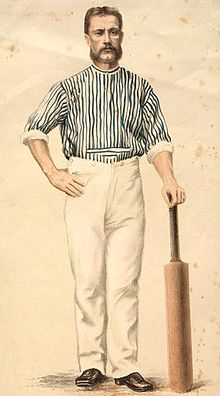- Charles Bannerman
-
Charles Bannerman Personal information Full name Charles Bannerman Born 3 July 1851
Woolwich, Kent, EnglandDied 20 August 1930 (aged 79)
Surry Hills, New South Wales, AustraliaBatting style Right-handed Bowling style Right-arm leg spin Role Umpire, coach International information National side Australia Test debut (cap 1) 15 March 1877 v England Last Test 4 January 1879 v England Domestic team information Years Team 1870 – 1888 New South Wales Umpiring information Tests umpired 12 Career statistics Competition Test FC Matches 3 44 Runs scored 239 1687 Batting average 59.75 21.62 100s/50s 1/0 1/9 Top score 165* 165* Balls bowled 0 137 Wickets – 0 Bowling average – – 5 wickets in innings – 0 10 wickets in match – 0 Best bowling – – Catches/stumpings 0/– 20/– Source: [1], 20 August 1930 Charles Bannerman (3 July 1851 – 20 August 1930) was an Australian Test cricketer, a right-hand batsman, who played domestic cricket for New South Wales.
Bannerman was born in Woolwich, Kent, England, son of William Bannerman and his wife Margaret, née Murphy. Not long afterwards the family migrated to New South Wales. He joined Warwick Cricket Club in Sydney.[1] He first played first-class cricket in 1870-71, and came to prominence by scoring 81 and 32 not out against Victoria in 1874. He played in the very first Test match, held at Melbourne in March 1877, and had the honour of facing the first ball ever bowled in Test cricket (the bowler being England's Alfred Shaw). Dropped before he reached double figures, he went on to 165 when he was forced to retire hurt, his finger being broken by a ball from George Ulyett. This was not only the first century scored in a Test match, but remains, more than 130 years later, the highest score by an Australian batsman on debut.
Also, his 165 runs, out of Australia's total of 245, is still the highest proportion (67.35%) of a completed innings in a Test match. No other Australian exceeded 20 in either innings, as Australia won this historic match by 45 runs. For his feat, spectators at the match collected £83/7/6 to present to him.
Bannerman played in the next two Tests, and in his brief Test career he scored 239 runs at an average of 59.75. On the first official tour of England in 1878 he topped the averages and scored the first century by an Australian in England, but no Test matches were played on this tour. He had a first-class batting average of 1,687 runs at 21.62. He retired after the first three Tests, officially through ill-health, but it was suggested that he could not cope with celebrity status, and that gambling debts and alcohol left him impoverished.
Between 1887 and 1902 he stood as umpire in 12 Test matches in Australia. His first match was between Australia and England in Sydney on 28 January to 31 January 1887, won by England by 13 runs after scoring a paltry 45 runs in their first innings. His colleague was Henry Rawlinson, standing in his only Test match. His last match, at Melbourne in 1901/02 season, was also a close low-scoring affair, with Australia winning by 32 runs. On this occasion his colleague was Bob Crockett standing in the first season of a long and illustrious Test umpiring career.
In two of the matches in which Charles Bannerman officiated, his brother Alick was a player. No accusations of bias could be made - Alick scored only 23 runs in four innings.
In the fifth Test in the 1897/98 series Bannerman turned down a confident LBW appeal against Australian batsman Joe Darling when the match was in a tense situation. The LBW seemed obvious but the bowler had run in front of the umpire who was unsighted and had to reject the appeal. Darling, then on 50, went on to 160, winning the match for Australia. After the game Bannerman lodged an official complaint against the English wicket-keeper who had accused him of cheating, and the player was rebuked.
In 1922-23 season the first radio broadcast of a cricket match anywhere in the world was a match played as a benefit for Charles Bannerman, from which he received £490. He died in Sydney, Australia survived by his widow Mary Ann, née King, two sons and three daughters; three of the children were the issue of his first marriage to Ellen, née Neale.
Contents
See also
- History of Test cricket (to 1883)
- List of Australian Test cricketers
- Australian Test Cricket Umpires
- List of Test umpires
Notes
- ^ M. Z. Forbes (1969). "Bannerman, Charles (1851 - 1930)". Australian Dictionary of Biography, Volume 3. MUP. pp. 86–87. http://www.adb.online.anu.edu.au/biogs/A030086b.htm. Retrieved 2008-02-02.
References
- Pollard, Jack, Australian Cricket: 1803-1893, The Formative Years. Sydney, The Book Company, 1995. (ISBN 0-207-15490-2)
- Pollard, Jack, Australian Cricket: 1893-1917, The Turbulent Years. Sydney, The Book Company, 1995. (ISBN 0-207-15468-6)
- Pollard, Jack, Australian Cricket: The Game and the Players. Sydney, Hodder & Stoughton, 1982. (ISBN 0-340-28796-9)
External links
Records Preceded by
First holderWorld Record - Highest individual score in Test cricket
165 not out vs England at Melbourne 1876-77Succeeded by
Billy MurdochCategories:- 1851 births
- 1930 deaths
- Sportspeople from Sydney
- Australian cricketers
- Australia Test cricketers
- New South Wales cricketers
- Australian cricket umpires
- Cricketers who made a century on Test debut
Wikimedia Foundation. 2010.

